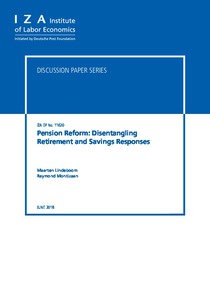Pension reform: disentangling retirement and savings responses

Lindeboom, Maarten ; Montizaan, Raymond
Institute of Labor Economics, Bonn
IZA - Bonn
2018
56 p.
pension reform ; pension scheme ; retirement ; private pension scheme
Discussion Paper
11620
Social protection - Old age benefits
English
Bibliogr.
"In January 2006, the Dutch government implemented a pension reform that substantially reduced the public pension wealth of workers born in 1950 or later. At the same time, a tax-facilitated savings plan was introduced that substantially reduced the saving costs of all workers, irrespective of birth year. This paper uses linked administrative and survey data to assess the effect of the reform on the savings and retirement expectations and realizations of two virtually identical male cohorts that differ only in treatment status, the treated having been born in 1950 and the controls having been born in 1949. We show that retirement expectations are in line with realizations and that the reform had the intended effect on the labor supply for the larger part of the workers, namely, those without sufficient means to substantially increase private savings to counter the effect of the reform. These workers, who are generally in worse health, have zero substitution rates between private and public wealth. On the other hand, there is a group of mostly high-wage workers who participate in the tax-facilitated Life Course Savings Scheme and who increase private savings to fully counter the impact of the drop in public wealth. A further, unintended side effect of the introduction of the tax-facilitated savings plan is that high wage earners who are not affected by the drop in pension wealth retire even sooner than initially planned."
Digital
The ETUI is co-funded by the European Union. Views and opinions expressed are however those of the author(s) only and do not necessarily reflect those of the European Union or the ETUI.